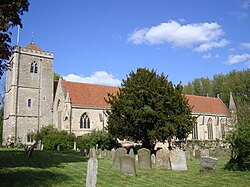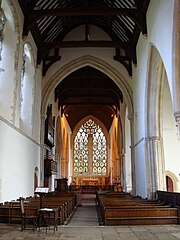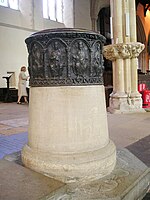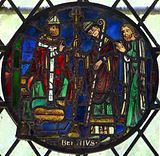Dorchester Abbey
| Dorchester Abbey | |
|
Abbey Church of St Peter and St Paul, | |
|---|---|
|
Dorchester on Thames, Oxfordshire | |
| Status: | Parish church |
 Dorchester Abbey viewed from the south | |
| Church of England | |
| Diocese of Oxford | |
| Location | |
| Grid reference: | SU57929421 |
| Location: | 51°38’37"N, 1°9’52"W |
| Address: | High Street |
| History | |
| Information | |
| Website: | Dorchester Abbey |
The Abbey Church of St Peter and St Paul, more usually called Dorchester Abbey, is a Church of England parish church in Dorchester on Thames in Oxfordshire, about eight miles south-east of Oxford. It was formerly a Norman abbey church and was built on the site of a Saxon cathedral.
History


Dorchester had been a Roman town. In 634, Birinius established it as the seat of a bishopric, serving Wessex. Later the town fell to the Mercians.[1] In 1085 the Mercian See (hitherto at Dorchester) was transferred to Lincoln.
Alexander, Bishop of Lincoln founded Dorchester Abbey in 1140 for the Arrouaisian Order of Augustinian Canons Regular (who wore white instead of the black of most Augustinian canons). It was dedicated in honour of Saints Peter and Paul and Birinus, and was richly endowed out of the lands and tithes of the former bishopric, and had twelve parishes subject to it, being included in the Peculiar of Dorchester, until the suppression of peculiars. The first abbot appears to have been Alured, whose name occurs in records from in 1146 and again in 1163. The last was John Mershe, who was elected in 1533, and in the following year subscribed to the king's supremacy, with five of his canons, and was given a pension of £22 a year. The revenues of the abbey were valued at the time of its suppression at about £220. Henry VIII reserved the greater part of the property of the house for a college, erected by him in honour of the Holy Trinity, for a dean and prebendaries; but this was dissolved in the first year of his successor, Edward VI.
In 1536, the Abbey was affected by the Dissolution of the monasteries and the monastic buildings were lost and St Birinus' shrine was destroyed. However, the church was saved because a local man called Richard Beauforest paid Henry VIII £140, and he gifted it to the people of the Dorchester parish in 1554. Later in 1602, the tower was rebuilt.[2]
No register or cartulary of Dorchester Abbey is known to exist, and only a single charter, confirming the donation of a church by King John, is given by Dugdale. Edmund Ashefeld was the first impropriator of the abbey site and precincts, which afterwards passed through various hands.
Church

The church of Dorchester Abbey, as it stands today, was built entirely by the Augustinian Canons, although there are traces on the north side of Saxon masonry, probably part of the ancient cathedral. The whole length of the church is 230 feet, its width 70 feet and its height 55 feet. The north transept and its doorway are Norman.
The north side of the nave and chancel arch are Early English Gothic. The choir, south side of nave, south aisle are Decorated Gothic. The south porch is late Perpendicular Gothic. The very rich sanctuary, with its highly decorated windows (including the famous east window one known as the Jesse Tree window) and ornately carved sedilia and piscina, dates from 1330.
Other fittings include one of the few surviving lead fonts in the land, frescoes of 1340 and several monuments, especially the well-known "swaggering knight" effigy formerly believed to be Sir John Holcombe who died in 1270 but it is more likely that it is William de Valence the Younger (died 1282 [3] at the Battle of Llandeilo Fawr), son of William de Valence, 1st Earl of Pembroke.
Over a period of some forty years from 1845, restoration was carried out on an intermittent basis successively under the direction of four architects: James Cranston, William Butterfield, Sir George Gilbert Scott and Joseph Maltby Bignell (from 1878 to 1883). Scott had earlier employed his pupil, Bignell, as clerk of works at Dorchester [from 1859].[4]
In 1993 a Union Jack that had been draped over the coffins of prisoners of war at Batu Lintang camp, Sarawak, Borneo was placed in the abbey together with two wooden memorial plaques; they had formerly been housed at All Saints Church, Oxford.[5]
Outside links
| ("Wikimedia Commons" has material about Dorchester Abbey) |
References
- ↑ Doggett, Nicholas: 'The Anglo-Saxon See and Cathedral of Dorchester-on-Thames: the Evidence Reconsidered – Oxoniensia, 1986
- ↑ "Abbey History - The post-reformation period". https://www.dorchester-abbey.org.uk/abbey-history/.
- ↑ "History 3". Dorchester Abbey. Dorchester Abbey. http://www.dorchester-abbey.org.uk/history3.htm.
- ↑ Dorchester Abbey, Oxfordshire: The Archaeology and Architecture ... by Warwick Rodwell (Oxford: Oxbow Books, 2009)
- ↑ Taylor, Brian (2006). "Lintang Camp memorial". The Sarawak Museum Journal 62 (83): 59–62.
- Cunningham, CJK; Banks, JW (1972). "Excavations at Dorchester Abbey, Oxon". Oxoniensia (Oxfordshire Architectural and Historical Society) XXXVII: 158–164. http://oxoniensia.org/volumes/1972/cunningham.pdf.
- Oxoniensia - The Oxfordshire Architectural and Historical Society:
- Doggett, Nicholas (1986). "The Anglo-Saxon See and Cathedral of Dorchester-on-Thames: the Evidence Reconsidered". Oxoniensia (Oxfordshire Architectural and Historical Society) LI: 49–61. http://oxoniensia.org/volumes/1986/doggett.pdf.
- Keevill, Graham D (2003). Archaeological Investigations in 2001 at the Abbey Church of St. Peter and St. Paul, Dorchester-on-Thames, Oxfordshire. LXVIII. pp. 313–362. http://oxoniensia.org/volumes/2003/keevill.pdf.
- Lankester, Philip J (1987). "A Military Effigy in Dorchester Abbey, Oxon.". Oxoniensia LII: 145–172. http://oxoniensia.org/volumes/1987/lankester.pdf.
- A History of the County of Oxford - Volume 7 pp 39-64: Parishes: Dorchester (Victoria County History)
- A History of the County of Oxford - Volume 2 pp 87-90: Ecclesiastical History (Victoria County History)
- Rodwell, Warwick (2009). Dorchester Abbey, Oxfordshire: The Archaeology and Architecture of a Cathedral, Monastery and Parish Church. Oxford: Oxbow Books. ISBN 978-1-84217-388-6.
- Nikolaus Pevsner: The Buildings of England: Oxfordshire, 1974 Penguin Books ISBN 978-0-300-09639-2
- Tiller, Kate, ed (2005). Dorchester Abbey: Church and People 635–2005. Stonesfield Press. ISBN 0-9527126-4-4.
